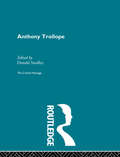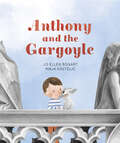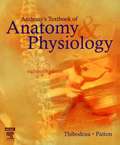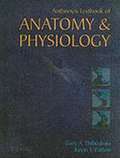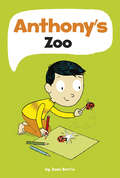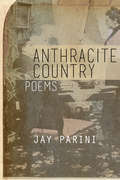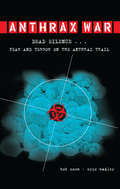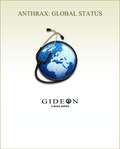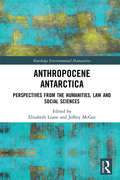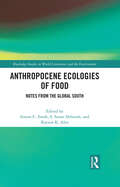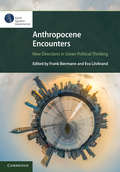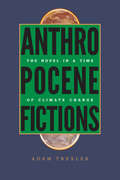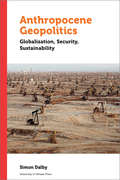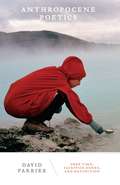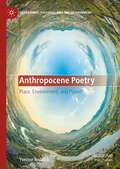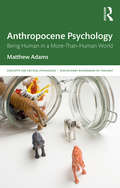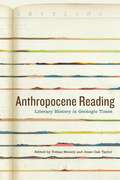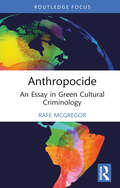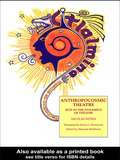- Table View
- List View
Anthony Trollope: The Critical Heritage (Critical Heritage Ser.)
by Donald SmalleyFirst Published in 1995. Routledge is an imprint of Taylor & Francis, an informa company.
Anthony and the Gargoyle
by Jo Ellen BogartA boy befriends a baby gargoyle in this magical wordless story in graphic-novel style from award-winning creators Jo Ellen Bogart and Maja Kastelic. Anthony’s house is full of family photos — of his parents’ trip to Paris, his great aunt, and Anthony himself as a toddler, holding his favorite rock. When Anthony wakes up one morning, he sees that his “rock” has cracked open — it’s hollow inside. He doesn’t see the little face peering out from the closet. Later, he discovers the newly hatched creature and they become friends. Anthony asks his mother about the rock, and she shows him a photo album of a trip to Paris. Anthony sees that his friend resembles the gargoyles at Notre-Dame cathedral. Back in his room, he shows the photos to the baby gargoyle who looks at them with longing. News arrives that Anthony’s great aunt is in hospital. The family travel to Paris to visit, and Anthony secretly brings the baby gargoyle. When the family have a chance to climb Notre-Dame’s tower, Anthony and his friend wander from one gargoyle to the next … until the baby gargoyle sees one that looks just like him. A bittersweet story of true friendship and letting go. Key Text Features comic comic strips Correlates to the Common Core State Standards in English Language Arts: CCSS.ELA-LITERACY.RL.1.7 Use illustrations and details in a story to describe its characters, setting, or events. CCSS.ELA-LITERACY.RL.2.3 Describe how characters in a story respond to major events and challenges.
Anthony's Textbook of Anatomy & Physiology
by Gary A. Thibodeau Kevin T. PattonThis 17th edition of a text for courses in anatomy and physiology integrates recent discoveries on the genetic basis of body structure and function. The art program includes color dissection photos, light micrographs, and scanning and transmission electron micrographs, some new to this edition. Thibodeau is professor emeritus of biology at the University of Wisconsin; Patton teaches life science at Saint Charles Community College. Annotation (c)2003 Book News, Inc. , Portland, OR (booknews. com)
Anthony's Textbook of Anatomy and Physiology (17th Edition)
by Gary A. Thibodeau Kevin T. PattonThis is a textbook that will help students avoid becoming lost in a maze of facts in a complex learning environment. It will encourage them to explore, to question, and to look for relationships not only between related facts in a single discipline but also between fields of academic inquiry and personal experience.
Anthony's Zoo (Wordless Graphic Novels)
by Juan BerrioAnthony begins his day at home with nothing but his colored pencils to keep him company. Soon an animal visitor arrives and then so does another one. Then more and more and more. What will happen when Mom sees the wildlife in the house? Find out in this wordless graphic novel in which the artwork brings the story to life.
Anthrax War: Dead Silence . . . Fear and Terror on the Anthrax Trail
by Bob Coen Eric NadlerAn investigation into the 2001 U.S. anthrax attacks leads to the realization that a new and terrible arms race may soon be upon us, one that spans the globe and is driven by an array of forces working with deadly microorganisms. Penetrating what they regard as an international "bioweapons mafia," Bob Coen and Eric Nadler encounter scientists, capitalists, politicians, and assassins — all playing with the world's most dangerous germs.Coen and Nadler pursue leads across four continents in an attempt to illuminate the secret world of international biological weapons research. They probe the mysterious deaths of some of the world's leading germ war scientists, including the death of Bruce Ivins — the man the FBI controversially insists is the lone perpetrator of the anthrax attacks. They also examine the suspicious suicide of British scientist and weapons inspector David Kelly, who was found dead in the woods the same week U.K. officials killed an investigation into illegal human experimentation at the top–secret facility where he once worked.As the plot darkens, it becomes clear that the 2001 anthrax attacks are a portal into a new and lucrative "biomilitary–industrial complex," and one of the most frightening stories of our time.
Anthrax: Global Status 2010 edition
by Dr Stephen Berger Gideon InformaticsAnthrax: Global Status is one in a series of GIDEON ebooks which summarize the status of individual infectious diseases, in every country of the world. Data are based on the GIDEON database (www.gideononline.com) which relies on standard text books, peer-review journals, Health Ministry reports and ProMED, supplemented by an ongoing search of the medical literature. Chapters are arranged alphabetically, by country name. Each section is divided into six subsections. 1. Descriptive epidemiology 2. Summary of clinical features 3. Global status of the disease4. Potential use in Bioterrorism 5. Status of the disease in a specific country 6. References
Anthro-Vision: A New Way to See in Business and Life
by Gillian TettIn an age when the business world is dominated by technology and data analysis, award-winning financial journalist and anthropology PhD Gillian Tett presents a radically different strategy for success: businesses can revolutionize their understanding of behavior by studying consumers, markets, and organizations through an anthropological lens. Amid severe digital disruption, economic upheaval, and political flux, how can we make sense of the world? Leaders today typically look for answers in economic models, Big Data, or artificial intelligence platforms. Gillian Tett points to anthropology—the study of human culture. Anthropologists train to get inside the minds of other people, helping them not only to understand other cultures but also to appraise their own environment with fresh perspective as an insider-outsider, gaining lateral vision. Today, anthropologists are more likely to study Amazon warehouses than remote Amazon tribes; they have done research into institutions and companies such as General Motors, Nestlé, Intel, and more, shedding light on practical questions such as how internet users really define themselves; why corporate projects fail; why bank traders miscalculate losses; how companies sell products like pet food and pensions; why pandemic policies succeed (or not). Anthropology makes the familiar seem unfamiliar and vice versa, giving us badly needed three-dimensional perspective in a world where many executives are plagued by tunnel vision, especially in fields like finance and technology. Lively, lucid, and practical, Anthro-Vision offers a revolutionary new way for understanding the behavior of organizations, individuals, and markets in today&’s ever-evolving world.
Anthropic Bias: Observation Selection Effects in Science and Philosophy
by Nick BostromAnthropic Bias explores how to reason when you suspect that your evidence is biased by "observation selection effects"--that is, evidence that has been filtered by the precondition that there be some suitably positioned observer to "have" the evidence. This conundrum--sometimes alluded to as "the anthropic principle," "self-locating belief," or "indexical information"--turns out to be a surprisingly perplexing and intellectually stimulating challenge, one abounding with important implications for many areas in science and philosophy. There are the philosophical thought experiments and paradoxes: the Doomsday Argument; Sleeping Beauty; the Presumptuous Philosopher; Adam & Eve; the Absent-Minded Driver; the Shooting Room. And there are the applications in contemporary science: cosmology ("How many universes are there?", "Why does the universe appear fine-tuned for life?"); evolutionary theory ("How improbable was the evolution of intelligent life on our planet?"); the problem of time's arrow ("Can it be given a thermodynamic explanation?"); quantum physics ("How can the many-worlds theory be tested?"); game-theory problems with imperfect recall ("How to model them?"); even traffic analysis ("Why is the 'next lane' faster?"). Anthropic Bias argues that the same principles are at work across all these domains. And it offers a synthesis: a mathematically explicit theory of observation selection effects that attempts to meet scientific needs while steering clear of philosophical paradox.
Anthropocene Antarctica: Perspectives from the Humanities, Law and Social Sciences (Routledge Environmental Humanities)
by Elizabeth Leane Jeffrey McGeeAnthropocene Antarctica offers new ways of thinking about the ‘Continent for Science and Peace’ in a time of planetary environmental change. In the Anthropocene, Antarctica has become central to the Earth’s future. Ice cores taken from its interior reveal the deep environmental history of the planet and warming ocean currents are ominously destabilising the glaciers around its edges, presaging sea-level rise in decades and centuries to come. At the same time, proliferating research stations and tourist numbers challenge stereotypes of the continent as the ‘last wilderness.’ The Anthropocene brings Antarctica nearer in thought, entangled with our everyday actions. If the Anthropocene signals the end of the idea of Nature as separate from humans, then the Antarctic, long considered the material embodiment of this idea, faces a radical reframing. Understanding the southern polar region in the twenty-first century requires contributions across the disciplinary spectrum. This collection paves the way for researchers in the Environmental Humanities, Law and Social Sciences to engage critically with the Antarctic, fostering a community of scholars who can act with natural scientists to address the globally significant environmental issues that face this vitally important part of the planet.
Anthropocene Ecologies of Food: Notes from the Global South (Routledge Studies in World Literatures and the Environment)
by Simon C EstokAnthropocene Ecologies of Food provides a detailed exploration of cross-cultural aspects of food production, culinary practices, and their ecological underpinning in culture. The authors draw connections between humans and the entire process of global food production focusing on the broad implications these processes have within the geographical and cultural context of India. Each chapter analyzes and critiques existing agricultural/food practices, and representations of aspects of food through various media (such as film, literature, and new media) as they relate to global issues generally and Indian contexts specifically, correcting the omission of analyses focused on the Global South in virtually all of the work that has been done on "Anthropocene ecologies of food." This unique volume employs an ecocritical framework that connects food with the land, in physical and virtual communities, and the book as a whole interrogates the meanings and implications of the Anthropocene itself.
Anthropocene Encounters: New Directions in Green Political Thinking
by Frank Biermann Eva LövbrandCoined barely two decades ago, the Anthropocene has become one of the most influential and controversial terms in environmental policy. Yet it remains an ambivalent and contested formulation, giving rise to a multitude of unexpected, and often uncomfortable, conversations. This book traces in detail a broad variety of such 'Anthropocene encounters': in science, philosophy and literary fiction. It asks what it means to 'think green' in a time when nature no longer offers a stable backdrop to political analysis. Do familiar political categories and concepts, such as democracy, justice, power and time, hold when confronted with a world radically transformed by humans? The book responds by inviting more radical political thought, plural forms of engagement, and extended ethical commitments, making it a fascinating and timely volume for graduate students and researchers working in earth system governance, environmental politics and studies of the Anthropocene.
Anthropocene Feminism (21st Century Studies)
by Richard GrusinWhat does feminism have to say to the Anthropocene? How does the concept of the Anthropocene impact feminism? This book is a daring and provocative response to the masculinist and techno-normative approach to the Anthropocene so often taken by technoscientists, artists, humanists, and social scientists. By coining and, for the first time, fully exploring the concept of &“anthropocene feminism,&” it highlights the alternatives feminism and queer theory can offer for thinking about the Anthropocene. Feminist theory has long been concerned with the anthropogenic impact of humans, particularly men, on nature. Consequently, the contributors to this volume explore not only what current interest in the Anthropocene might mean for feminism but also what it is that feminist theory can contribute to technoscientific understandings of the Anthropocene. With essays from prominent environmental and feminist scholars on topics ranging from Hawaiian poetry to Foucault to shelled creatures to hypomodernity to posthuman feminism, this book highlights both why we need an anthropocene feminism and why thinking about the Anthropocene must come from feminism. Contributors: Stacy Alaimo, U of Texas at Arlington; Rosi Braidotti, Utrecht U; Joshua Clover, U of California, Davis; Claire Colebrook, Pennsylvania State U; Dehlia Hannah, Arizona State U; Myra J. Hird, Queen&’s U; Lynne Huffer, Emory U; Natalie Jeremijenko, New York U; Elizabeth A. Povinelli, Columbia U; Jill S. Schneiderman, Vassar College; Juliana Spahr, Mills College; Alexander Zahara, Queen&’s U.
Anthropocene Fictions: The Novel in a Time of Climate Change (Under the Sign of Nature: Explorations in Ecocriticism)
by Adam TrexlerSince the Industrial Revolution, humans have transformed the Earth's atmosphere, committing our planet to more extreme weather, rising sea levels, melting polar ice caps, and mass extinction. This period of observable human impact on the Earth's ecosystems has been called the Anthropocene Age. The anthropogenic climate change that has impacted the Earth has also affected our literature, but criticism of the contemporary novel has not adequately recognized the literary response to this level of environmental crisis. Ecocriticism's theories of place and planet, meanwhile, are troubled by a climate that is neither natural nor under human control. Anthropocene Fictions is the first systematic examination of the hundreds of novels that have been written about anthropogenic climate change.Drawing on climatology, the sociology and philosophy of science, geography, and environmental economics, Adam Trexler argues that the novel has become an essential tool to construct meaning in an age of climate change. The novel expands the reach of climate science beyond the laboratory or model, turning abstract predictions into subjectively tangible experiences of place, identity, and culture. Political and economic organizations are also being transformed by their struggle for sustainability. In turn, the novel has been forced to adapt to new boundaries between truth and fabrication, nature and economies, and individual choice and larger systems of natural phenomena. Anthropocene Fictions argues that new modes of inhabiting climate are of the utmost critical and political importance, when unprecedented scientific consensus has failed to lead to action. Under the Sign of Nature: Explorations in Ecocriticism
Anthropocene Geopolitics: Globalization, Security, Sustainability (Politics and Public Policy)
by Simon DalbyWe now find ourselves in a new geological age: the Anthropocene. The climate is changing and species are disappearing at a rate not seen since Earth’s major extinctions. The rapid, large-scale changes caused by fossil-fuel powered globalization increasingly threaten societies in new, unforeseen ways. But most security policies continue to be built on notions that look backward to a time when geopolitical threats derived mainly from the rivalries of states with fixed boundaries. Instead, Anthropocene Geopolitics shows that security policy must look forward to quickly shape a sustainable world no longer dependent on fossil fuels. A future of long-term peace and geopolitical security depends on keeping the earth in conditions roughly similar to those we have known throughout history. Minimizing disruptions that would further put civilization at risk of extinction urgently requires policies that reflect new Anthropocene “planetary boundaries.” This book is published in English. - Depuis la fin de la dernière période glaciaire, l’humanité a transformé sa niche écologique, modifié sa position dans l’écosystème, provoqué des changements climatiques radicaux et affecté la diversité des espèces aux quatre coins du monde, ce qui a entraîné l’apparition d’une nouvelle époque géologique, l’Anthropocène. À l’échelle planétaire, les activités humaines exercent un impact direct sur les frontières qu’elles transforment durablement alors que ces mêmes frontières ont constitué le cadre naturel dans lequel l’humanité a pu prospérer durant les dix derniers millénaires. Les changements rapides qui affectent notre système terrestre remettent directement en cause les anciennes hypothèses qui considéraient des frontières stables comme le principal fondement de la souveraineté. Aujourd’hui, ces postulats périmés doivent impérativement être réévalués. Paradoxalement, la phase de mondialisation actuelle nécessite une redéfinition de la notion même de frontières stables. En effet, l’élargissement des droits de propriété et des champs de compétence pourrait en fait prévenir la mise en œuvre de mesures d’adaptation efficaces visant à répondre aux enjeux du changement climatique. Garantir la survie d’une économie fondée sur la consommation de combustibles fossiles demeure à ce jour une priorité politique comme le fait de devoir faire face aux catastrophes naturelles à l’échelle mondiale – ce qui rend les objectifs de durabilité d’autant plus difficiles à atteindre dans un environnement en pleine mutation où les rivalités politiques exacerbées façonnent la politique globale contemporaine. L’entrée de la Terre dans une nouvelle époque géologique, l’Anthropocène (l’ère de l’homme), représente un formidable défi éthique, qu’il convient de relever en établissant une véritable politique de durabilité, et ce, au moment où l’humanité s’engage dans la dernière phase du processus de mondialisation. Dans un tel contexte, pour être réellement efficaces, les connaissances et les perspectives résultant des analyses académiques et des initiatives pratiques de toute nature devront être intégrées dans une vision globale.
Anthropocene Poetics: Deep Time, Sacrifice Zones, and Extinction (Posthumanities #50)
by David FarrierHow poetry can help us think about and live in the Anthropocene by reframing our intimate relationship with geological time The Anthropocene describes how humanity has radically intruded into deep time, the vast timescales that shape the Earth system and all life-forms that it supports. The challenge it poses—how to live in our present moment alongside deep pasts and futures—brings into sharp focus the importance of grasping the nature of our intimate relationship with geological time. In Anthropocene Poetics, David Farrier shows how contemporary poetry by Elizabeth Bishop, Seamus Heaney, Evelyn Reilly, and Christian Bök, among others, provides us with frameworks for thinking about this uncanny sense of time.Looking at a diverse array of lyric and avant-garde poetry from three interrelated perspectives—the Anthropocene and the &“material turn&” in environmental philosophy; the Plantationocene and the role of global capitalism in environmental crisis; and the emergence of multispecies ethics and extinction studies—Farrier rethinks the environmental humanities from a literary critical perspective. Anthropocene Poetics puts a concern with deep time at the center, defining a new poetics for thinking through humanity&’s role as geological agents, the devastation caused by resource extraction, and the looming extinction crisis.
Anthropocene Poetry: Place, Environment, and Planet (Literatures, Cultures, and the Environment)
by Yvonne ReddickAnthropocene Poetry: Place, Environment and Planet argues that the idea of the Anthropocene is inspiring new possibilities for poetry. It can also change the way we read and interpret poems. If environmental poetry was once viewed as linked to place, this book shows how poets are now grappling with environmental issues from the local to the planetary: climate change and the extinction crisis, nuclear weapons and waste, plastic pollution and the petroleum industry. This book intervenes in debates about culture and science, traditional poetic form and experimental ecopoetics, to show how poets are collaborating with environmental scientists and joining environmental activist movements to respond to this time of crisis. From the canonical work of Ted Hughes and Seamus Heaney, to award-winning poets Alice Oswald, Pascale Petit, Kei Miller, and Karen McCarthy Woolf, this book explores major figures from the past alongside acclaimed contemporary voices. It reveals Seamus Heaney’s support for conservation causes and Ted Hughes’s astonishingly forward-thinking research on climate change; it discusses how Pascale Petit has given poetry to Extinction Rebellion and how Karen McCarthy Woolf set sail with scientists to write about plastic pollution. This book deploys research on five poetry archives in the UK, USA and Ireland, and the author’s insider insights into the commissioning processes and collaborative methods that shaped important contemporary poetry publications. Anthropocene Poetry finds that environmental poetry is flourishing in the face of ecological devastation. Such poetry speaks of the anxieties and dilemmas of our age, and searches for paths towards resilience and resistance.
Anthropocene Psychology: Being Human in a More-than-Human World (Concepts for Critical Psychology)
by Matthew AdamsThis ground-breaking book critically extends the psychological project, seeking to investigate the relations between human and more-than-human worlds against the backdrop of the Anthropocene by emphasising the significance of encounter, interaction and relationships. Interdisciplinary environmental theorist Matthew Adams draws inspiration from a wealth of ideas emerging in human–animal studies, anthrozoology, multi-species ethnography and posthumanism, offering a framing of collective anthropogenic ecological crises to provocatively argue that the Anthropocene is also an invitation – to become conscious of the ways in which human and nonhuman are inextricably connected. Through a series of strange encounters between human and nonhuman worlds, Adams argues for the importance of cultivating attentiveness to the specific and situated ways in which the fates of multiple species are bound together in the Anthropocene. Throughout the book this argument is put into practice, incorporating everything from Pavlov’s dogs, broiler chickens, urban trees, grazing sheep and beached whales, to argue that the Anthropocene can be good to think with, conducive to a seeing ourselves and our place in the world with a renewed sense of connection, responsibility and love. Building on developments in feminist and social theory, anthropology, ecopsychology, environmental psychology, (post)humanities, psychoanalysis and phenomenology, this is fascinating reading for academics and students in the field of critical psychology, environmental psychology, and human–animal studies.
Anthropocene Reading: Literary History in Geologic Times (AnthropoScene)
by Steve Mentz Dana Luciano Jeffrey Jerome Cohen Jennifer Wenzel Benjamin Morgan Thomas H. Ford Stephanie LeMenager Justin Neuman Juliana Chow Noah Heringman Matt Hooley Derek Woods Anne-Lise FrançoisFew terms have garnered more attention recently in the sciences, humanities, and public sphere than the Anthropocene, the proposed epoch in which a human “signature” appears in the lithostratigraphic record. Anthropocene Reading considers the implications of this concept for literary history and critical method.Entering into conversation with geologists and geographers, this volume reinterprets the cultural past in relation to the anthropogenic transformation of the Earth system while showcasing how literary analysis may help us conceptualize this geohistorical event. The contributors examine how a range of literary texts, from The Tempest to contemporary dystopian novels to the poetry of Emily Dickinson, mediate the convergence of the social institutions, energy regimes, and planetary systems that support the reproduction of life. They explore the long-standing dialogue between imaginative literature and the earth sciences and show how scientists, novelists, and poets represent intersections of geological and human timescales, the deep past and a posthuman future, political exigency and the carbon cycle.Accessibly written and representing a range of methodological perspectives, the essays in this volume consider what it means to read literary history in the Anthropocene.Contributors include Juliana Chow, Jeffrey Jerome Cohen, Thomas H. Ford, Anne-Lise François, Noah Heringman, Matt Hooley, Stephanie LeMenager, Dana Luciano, Steve Mentz, Benjamin Morgan, Justin Neuman, Jennifer Wenzel, and Derek Woods.
Anthropocene Reading: Literary History in Geologic Times (AnthropoScene: The SLSA Book Series #1)
by Tobias Menely Jesse Oak TaylorFew terms have garnered more attention recently in the sciences, humanities, and public sphere than the Anthropocene, the proposed epoch in which a human “signature” appears in the lithostratigraphic record. Anthropocene Reading considers the implications of this concept for literary history and critical method.Entering into conversation with geologists and geographers, this volume reinterprets the cultural past in relation to the anthropogenic transformation of the Earth system while showcasing how literary analysis may help us conceptualize this geohistorical event. The contributors examine how a range of literary texts, from The Tempest to contemporary dystopian novels to the poetry of Emily Dickinson, mediate the convergence of the social institutions, energy regimes, and planetary systems that support the reproduction of life. They explore the long-standing dialogue between imaginative literature and the earth sciences and show how scientists, novelists, and poets represent intersections of geological and human timescales, the deep past and a posthuman future, political exigency and the carbon cycle.Accessibly written and representing a range of methodological perspectives, the essays in this volume consider what it means to read literary history in the Anthropocene.Contributors include Juliana Chow, Jeffrey Jerome Cohen, Thomas H. Ford, Anne-Lise François, Noah Heringman, Matt Hooley, Stephanie LeMenager, Dana Luciano, Steve Mentz, Benjamin Morgan, Justin Neuman, Jennifer Wenzel, and Derek Woods.
Anthropocene and Cosmopolitan Citizenship: Europe and the New International Order (Federalism Studies)
by Guido MontaniAnthropocene and Cosmopolitan Citizenship criticizes the Westphalia system of international relations and, as an alternative, proposes cosmopolitan citizenship. The book offers a critique of the theory of international relations based on the Westphalian system and the principle of national sovereignty.At the end of the Second World War, the two superpowers agreed on a new international order that, to this day, has prevented a new world war. This era is over. The collapse of the Soviet Union and the economic and political affirmation of new international powers – such as China, India and Brazil – have generated a multipolar world, in which growing tensions between great and small powers are manifested, up to the threat of nuclear war. To this threat, a second one has been added: the possible collapse of the biosphere, an epoch called the Anthropocene, because the pollution of nature is suffocating the life of every living species on the Planet, including Homo sapiens. The United Nations can be viewed as the first step towards a post-Westphalian system, and the European Union represents an alternative model for peaceful relationships among national peoples. The book’s methodology draws on an interdisciplinary relationship between social sciences and nature sciences to provide a European foreign policy strategy that shows how the European Union can play a crucial role in current international politics, helping build a just world in harmony with nature, including by calling for a Global Green Deal and an Earth Constitution. The integration of the national peoples of the European Union shows that supranational citizenship is possible and that national independence is compatible with peaceful international interdependence. The author explores how this can be achieved and how alternatives have failed, with reference to federalism, ecologism, liberalism, democracy, socialism, nationalism, security and patriotism.This book will be of interest to scholars of international relations and European studies and activists, including ecologists, young people, federalists and members of political parties.
Anthropocide: An Essay in Green Cultural Criminology (Routledge Studies in Crime, Culture and Media)
by Rafe McGregorThrough an examination of Alfonso Cuarón’s Children of Men, this book demonstrates the ability of cinematic fictions, and other complex narrative fictions, to contribute to meeting the climate challenge by shaping the desires of audiences. What if there was a single feature film that showed us everything we need to know about climate catastrophe culture? What if that same film also made the philosophies of Slavoj Žižek, Mark Fisher, Francis Fukuyama, and Fredric Jameson accessible? Identifying the climate challenge as a cultural challenge, this book provides an unprecedented criminological analysis of both Children of Men and Fisher’s oeuvre from 1998 to 2022 and demonstrates the capacity of cinematic narratives to shape climate catastrophe culture. Seeking to be part of the solution to the climate challenge, it is the first criminological study to link the capacity of cinematic fictions to shape desire to solutions to the climate crisis. It is also one of the most detailed and most rigorous criminological case studies of a cinematic work to date.Anthropocide: An Essay in Green Cultural Criminology will be of great interest to students and scholars of green criminology, cultural criminology, narrative criminology, film theory, philosophy of film, and ecocriticism.
Anthropocosmic Theatre: Rite in the Dynamics of Theatre (Contemporary Theatre Studies #Vol. 13.)
by Nichos NunezFirst published in 1997. Routledge is an imprint of Taylor & Francis, an informa company.
